User:KJohnNR/sandbox
The Good Timeline.
Presidents[edit]
| No.[a] | Portrait | Name (Birth–Death) |
Term[1] | Party[b][2] | Election | Vice President[3] | |
|---|---|---|---|---|---|---|---|
| 1 | 
|
George Washington (1732–1799) [4] |
April 30, 1789 – March 4, 1797 |
Unaffiliated | 1788–1789
|
John Adams[c] | |
| 2 | 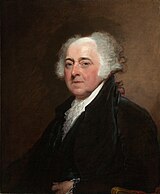
|
John Adams (1735–1826) [6] |
March 4, 1797 – March 4, 1801 |
Federalist | 1796 | Thomas Jefferson[d] | |
| 3 | 
|
Thomas Jefferson (1743–1826) [8] |
March 4, 1801 – March 4, 1809 |
Democratic- Republican |
1800 |
Aaron Burr
| |
| 4 | 
|
James Madison (1751–1836) [9] |
March 4, 1809 – March 4, 1817 |
Democratic- Republican |
1808
|
George Clinton[e]
Vacant after Vacant after | |
| 5 | 
|
James Monroe (1758–1831) [11] |
March 4, 1817 – March 4, 1825 |
Democratic- Republican |
1816
|
Daniel D. Tompkins | |
| 6 | 
|
John Quincy Adams (1767–1848) [12] |
March 4, 1825 – March 4, 1829 |
Democratic- Republican[f] |
1824 | John C. Calhoun[g] | |
| 7 | 
|
Andrew Jackson (1767–1845) [15] |
March 4, 1829 – March 4, 1837 |
Democratic | 1828
|
John C. Calhoun[h]
Vacant after | |
| 8 | 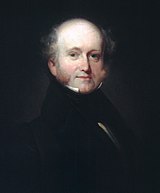
|
Martin Van Buren (1782–1862) [16] |
March 4, 1837 – March 4, 1841 |
Democratic | 1836 | Richard Mentor Johnson | |
| 9 | 
|
William Henry Harrison (1773–1841) [17] |
March 4, 1841 – April 4, 1841[e] |
Whig | 1840 | John Tyler | |
| 10 | 
|
John Tyler (1790–1862) [18] |
April 4, 1841[i] – March 4, 1845 |
Whig[j]
Unaffiliated |
– | Vacant throughout presidency | |
| 11 | 
|
James K. Polk (1795–1849) [21] |
March 4, 1845 – March 4, 1849 |
Democratic | 1844 | George M. Dallas | |
| 12 | 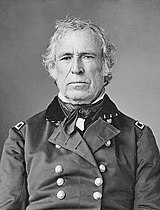
|
Zachary Taylor (1784–1850) [22] |
March 4, 1849 – July 9, 1850[e] |
Whig | 1848 | Millard Fillmore | |
| 13 | 
|
Millard Fillmore (1800–1874) [23] |
July 9, 1850[k] – March 4, 1853 |
Whig | – | Vacant throughout presidency | |
| 14 | 
|
Franklin Pierce (1804–1869) [25] |
March 4, 1853 – March 4, 1857 |
Democratic | 1852 | William R. King[e]
Vacant after | |
| 15 | 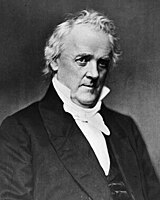
|
James Buchanan (1791–1868) [26] |
March 4, 1857 – March 4, 1861 |
Democratic | 1856 | John C. Breckinridge | |
| 16 | 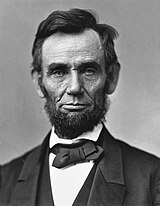
|
Abraham Lincoln (1809–1865) [27] |
March 4, 1861 – April 15, 1865[e] |
Republican
|
1860
|
Hannibal Hamlin
| |
| 17 | 
|
Andrew Johnson (1808–1875) [29] |
April 15, 1865[m] – March 4, 1869 |
National Union[n]
|
– | Vacant throughout presidency | |
| 18 | 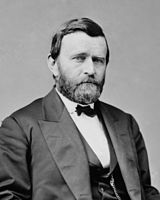
|
Ulysses S. Grant (1822–1885) [30] |
March 4, 1869 – March 4, 1877 |
Republican | 1868
|
Schuyler Colfax
Vacant after | |
| 19 | 
|
Rutherford B. Hayes (1822–1893) [31] |
March 4, 1877 – March 4, 1881 |
Republican | 1876 | William A. Wheeler | |
| 20 | 
|
James A. Garfield (1831–1881) [32] |
March 4, 1881 – September 19, 1881[e] |
Republican | 1880 | Chester A. Arthur | |
| 21 | 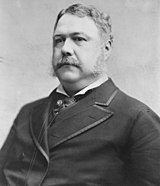
|
Chester A. Arthur (1829–1886) [33] |
September 19, 1881[o] – March 4, 1885 |
Republican | – | Vacant throughout presidency | |
| 22 | 
|
Grover Cleveland (1837–1908) [35] |
March 4, 1885 – March 4, 1889 |
Democratic | 1884 | Thomas A. Hendricks[e]
Vacant after | |
| 23 | 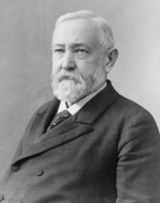
|
Benjamin Harrison (1833–1901) [36] |
March 4, 1889 – March 4, 1893 |
Republican | 1888 | Levi P. Morton | |
| 24 | 
|
Grover Cleveland (1837–1908) [35] |
March 4, 1893 – March 4, 1897 |
Democratic | 1892 | Adlai Stevenson I | |
| 25 | 
|
William McKinley (1843–1901) [37] |
March 4, 1897 – September 14, 1901[e] |
Republican | 1896
|
Garret Hobart[e]
Vacant after | |
| 26 | 
|
Theodore Roosevelt (1858–1919) [38] |
September 14, 1901[p] – March 4, 1909 |
Republican | –
|
Vacant through March 4, 1905 | |
| 27 | 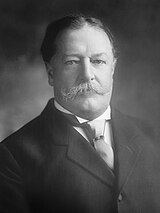
|
William Howard Taft (1857–1930) [40] |
March 4, 1909 – March 4, 1913 |
Republican | 1908 | James S. Sherman[e]
Vacant after | |
| 28 | 
|
Woodrow Wilson (1856–1924) [41] |
March 4, 1913 – March 4, 1921 |
Democratic | 1912
|
Thomas R. Marshall | |
| 29 | 
|
Warren G. Harding (1865–1923) [42] |
March 4, 1921 – August 2, 1923[e] |
Republican | 1920 | Calvin Coolidge | |
| 30 | 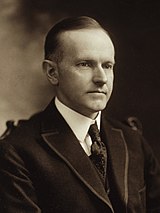
|
Calvin Coolidge (1872–1933) [43] |
August 2, 1923[q] – March 4, 1929 |
Republican | –
|
Vacant through March 4, 1925 | |
| 31 | 
|
Herbert Hoover (1874–1964) [45] |
March 4, 1929 – March 4, 1933 |
Republican | 1928 | Charles Curtis | |
| 32 | 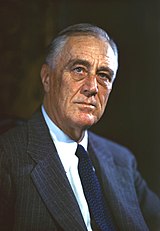
|
Franklin D. Roosevelt (1882–1945) [46] |
March 4, 1933 – April 12, 1945[e] |
Democratic | 1932
|
John Nance Garner
| |
| 33 | 
|
Harry S. Truman (1884–1972) [47] |
April 12, 1945[r] – January 20, 1953 |
Democratic | –
|
Vacant through January 20, 1949 | |
| 34 | 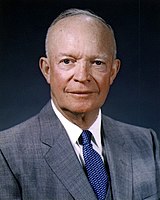
|
Dwight D. Eisenhower (1890–1969) [49] |
January 20, 1953 – January 20, 1961 |
Republican | 1952
|
Richard Nixon | |
| 35 | 
|
John F. Kennedy (1917–1963) [50] |
January 20, 1961 – November 22, 1963[e] |
Democratic | 1960 | Lyndon B. Johnson | |
| 36 | 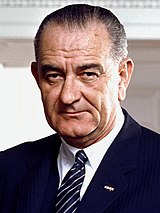
|
Lyndon B. Johnson (1908–1973) [51] |
November 22, 1963[s] – January 20, 1969 |
Democratic | –
|
Vacant through January 20, 1965 | |
| 37 | 
|
Richard Nixon (1913–1994) [53] |
January 20, 1969 – August 9, 1974[h] |
Republican | 1968
|
Spiro Agnew[h]
Vacant: | |
| 38 | 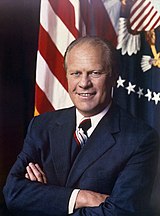
|
Gerald Ford (1913–2006) [54] |
August 9, 1974[u] – January 20, 1977 |
Republican | – | Vacant through December 19, 1974 | |
| 39 | 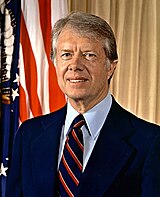
|
Jimmy Carter (b. 1924) [55] |
January 20, 1977 – January 20, 1985 |
Democratic | 1976
|
Walter Mondale | |
| 40 | 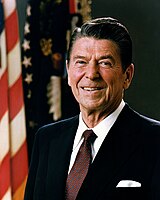
|
Ronald Reagan (1911–1990) [56] |
January 20, 1985 – November 29, 1990 |
Republican | 1984
|
George H. W. Bush | |
| 41 | 
|
George H. W. Bush (1924–2018) [57] |
November 29, 1990 – January 20, 1993 |
Republican | – | Vacant through January 9, 1991 | |
| 42 | 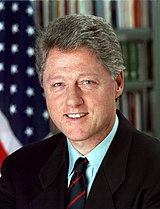
|
Bill Clinton (b. 1946) [58] |
January 20, 1993 – January 20, 2001 |
Democratic | 1992
|
Al Gore | |
| 43 | 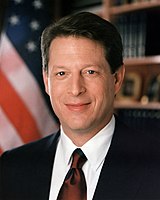
|
Al Gore (b. 1948) [58] |
January 20, 2001 – January 20, 2005 |
Democratic | 2000 | Joe Lieberman | |
| 44 | 
|
John McCain (b. 1946) [59] |
January 20, 2005 – January 20, 2009 |
Republican | 2004 | George Voinovich | |
| 45 | 
|
Barack Obama (b. 1961) [60] |
January 20, 2009 – January 20, 2017 |
Democratic | 2008
|
Joe Biden | |
| 46 | 
|
Bernie Sanders (b. 1941) [61] |
January 20, 2017 – Incumbent |
Democratic | 2016
|
Amy Klobuchar | |
- ^ Presidents are numbered according to uninterrupted periods served by the same person. For example, George Washington served two consecutive terms and is counted as the first president (not the first and second). Upon the resignation of 37th president, Richard Nixon, Gerald Ford became the 38th president even though he simply served out the remainder of Nixon's second term and was never elected to the presidency in his own right. Grover Cleveland was both the 22nd president and the 24th president because his two terms were not consecutive. A vice president who temporarily becomes acting president under the Twenty-fifth Amendment to the Constitution is not counted, because the president remains in office during such a period.
- ^ Reflects the president's political party at the start of their presidency. Changes during their time in office are noted. Also reflects the vice president's political party unless otherwise noted beside the individual's name.
- ^ Political parties had not been anticipated when the Constitution was drafted, nor did they exist at the time of the first presidential election in 1788–89. When they did develop, during Washington's first term, Adams joined the faction that became the Federalist Party. The elections of 1792 were the first ones in the United States that were contested on anything resembling a partisan basis.[5]
- ^ The 1796 presidential election was the first contested American presidential election and the only one in which a president and vice president were elected from opposing political parties. Federalist John Adams was elected president, and Jefferson of the Democratic-Republicans was elected vice president.[7]
- ^ a b c d e f g h i j k l m n o Died in office[10]
- ^ Early during John Quincy Adams' term the Democratic-Republican Party dissolved; his allies in Congress and at the state-level were referred to as "Adams' Men" during the Adams presidency. When Andrew Jackson became president in 1829, this group became the "Anti-Jackson" opposition, and organized themselves as the National Republican Party.[13]
- ^ John Calhoun, formerly a Democratic-Republican, founded the Nullifier Party in 1828 to oppose the Tariff of 1828 and advance the cause of states' rights, but was brought on as Andrew Jackson's running mate in the 1828 presidential election in an effort to broaden the democratic coalition led by Jackson.[14]
- ^ a b c Resigned from office[10]
- ^ John Tyler succeeded to the presidency upon the death of William Henry Harrison.[19]
- ^ John Tyler was elected vice president on the Whig Party ticket in 1840. His policy priorities as president soon proved to be opposed to most of the Whig agenda, and he was expelled from the party five months after assuming office.[20]
- ^ Millard Fillmore succeeded to the presidency upon the death of Zachary Taylor.[24]
- ^ When he ran for reelection in 1864, Republican Abraham Lincoln formed a bipartisan electoral alliance with War Democrats by selecting Democrat Andrew Johnson as his running mate, and running on the National Union Party ticket.[28]
- ^ Andrew Johnson succeeded to the presidency upon the death of Abraham Lincoln.[29]
- ^ While president, Andrew Johnson tried and failed to build a party of loyalists under the National Union banner. Near the end of his presidency, Johnson rejoined the Democratic Party.[29]
- ^ Chester A. Arthur succeeded to the presidency upon the death of James A. Garfield.[34]
- ^ Theodore Roosevelt succeeded to the presidency upon the death of William McKinley.[39]
- ^ Calvin Coolidge succeeded to the presidency upon the death of Warren G. Harding.[44]
- ^ Harry S. Truman succeeded to the presidency upon the death of Franklin D. Roosevelt.[48]
- ^ Lyndon B. Johnson succeeded to the presidency upon the death of John F. Kennedy.[52]
- ^ a b Appointed as vice president under terms of the Twenty-fifth Amendment, Section 2[10]
- ^ Gerald Ford succeeded to the presidency upon the resignation of Richard Nixon.[54]
- ^ LOC; whitehouse.gov.
- ^ Guide to U.S. Elections (2010), pp. 257–258.
- ^ LOC.
- ^ McDonald (2000).
- ^ Guide to U.S. Elections (2010), pp. 197, 272; Nardulli (1992), p. 179.
- ^ Pencak (2000).
- ^ Guide to U.S. Elections (2010), p. 274.
- ^ Peterson (2000).
- ^ Banning (2000).
- ^ a b c Neale (2004), p. 22.
- ^ Ammon (2000).
- ^ Hargreaves (2000).
- ^ Guide to U.S. Elections (2010), p. 228; Goldman (1951), p. 159.
- ^ Guide to U.S. Elections (2010), p. 892; Houpt (2010), pp. 26, 280.
- ^ Remini (2000).
- ^ Cole (2000).
- ^ Gutzman (2000).
- ^ Shade (2000).
- ^ Abbott (2013), p. 23.
- ^ Cash (2018), pp. 34–36.
- ^ Rawley (2000).
- ^ Smith (2000).
- ^ Anbinder (2000).
- ^ Abbott (2005), p. 639.
- ^ Gara (2000).
- ^ Gienapp (2000).
- ^ McPherson (b) (2000).
- ^ McSeveney (1986), p. 139.
- ^ a b c Trefousse (2000).
- ^ McPherson (a) (2000).
- ^ Hoogenboom (2000).
- ^ Peskin (2000).
- ^ Reeves (2000).
- ^ Greenberger (2017), pp. 174–175.
- ^ a b Campbell (2000).
- ^ Spetter (2000).
- ^ Gould (a) (2000).
- ^ Harbaugh (2000).
- ^ Abbott (2005), p. 639–640.
- ^ Gould (b) (2000).
- ^ Ambrosius (2000).
- ^ Hawley (2000).
- ^ McCoy (2000).
- ^ Senate.
- ^ Hoff (a) (2000).
- ^ Brinkley (2000).
- ^ Hamby (2000).
- ^ Abbott (2005), p. 636.
- ^ Ambrose (2000).
- ^ Parmet (2000).
- ^ Gardner (2000).
- ^ Abbott (2005), p. 633.
- ^ Hoff (b) (2000).
- ^ a b Greene (2013).
- ^ whitehouse.gov (a).
- ^ Schaller (2004).
- ^ whitehouse.gov (b).
- ^ a b whitehouse.gov (c).
- ^ whitehouse.gov (d).
- ^ whitehouse.gov (e).
- ^ whitehouse.gov (g).

